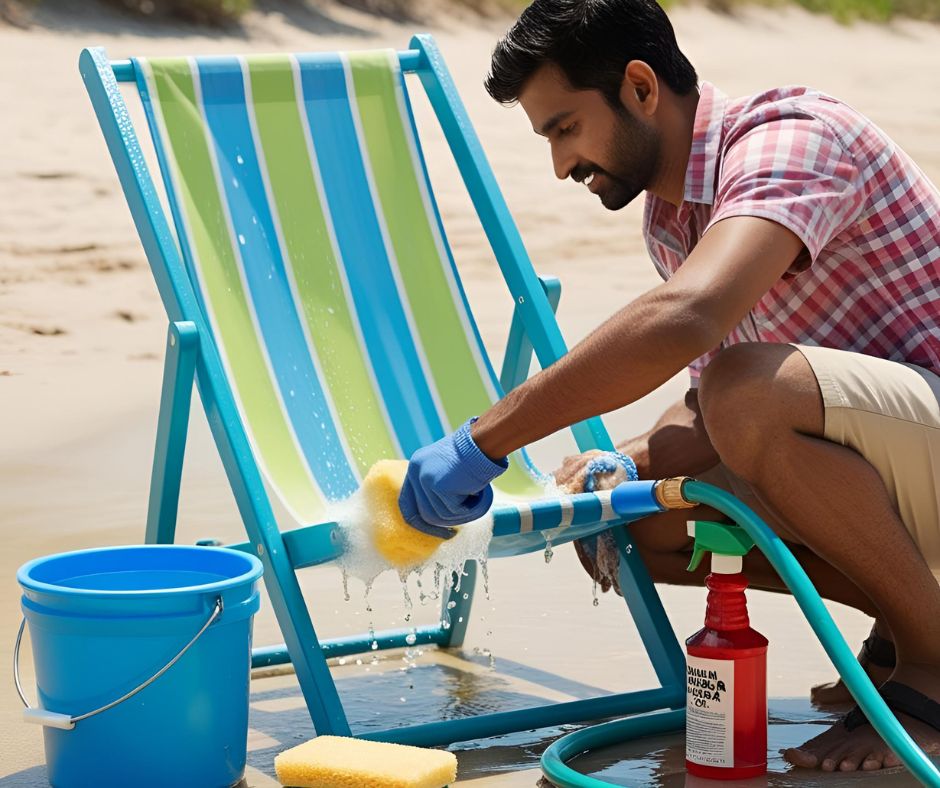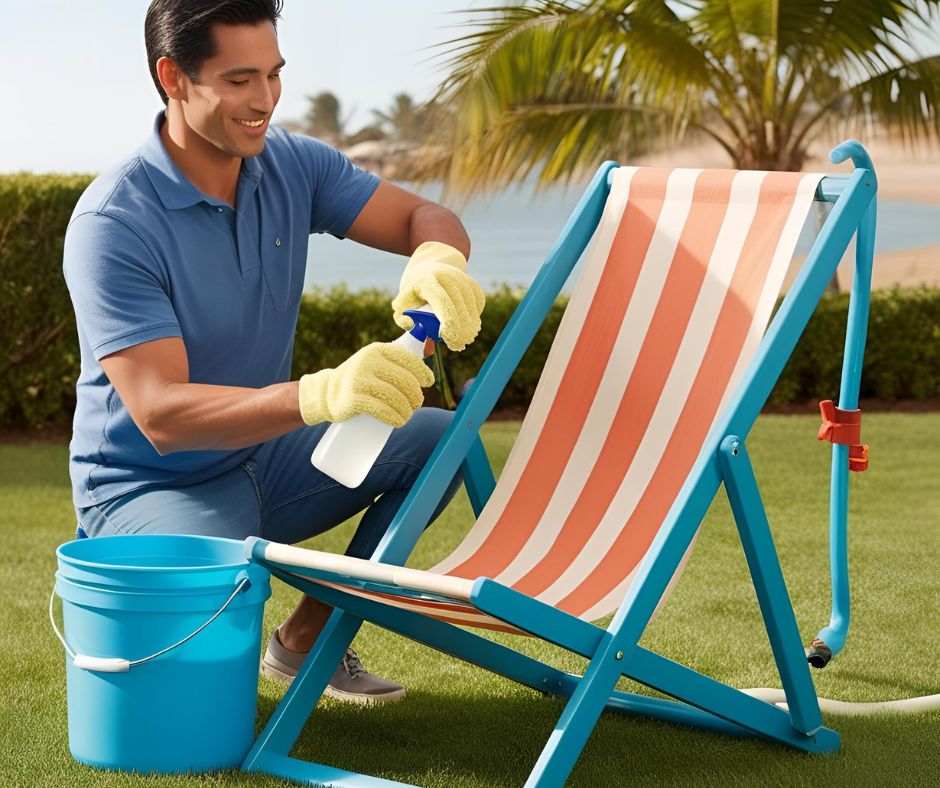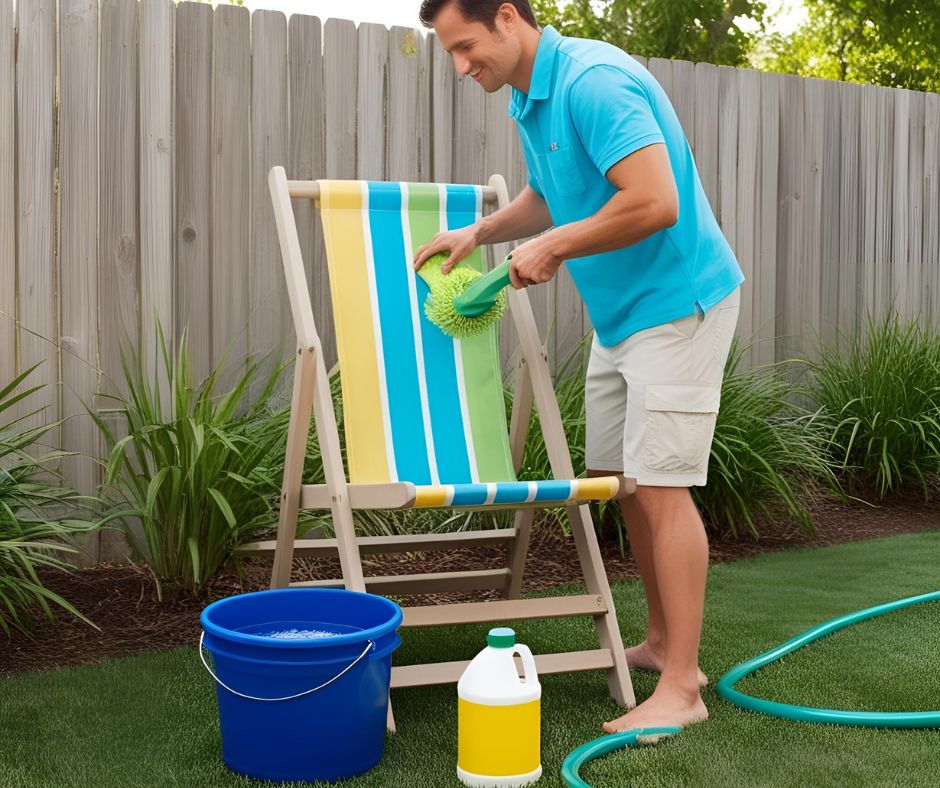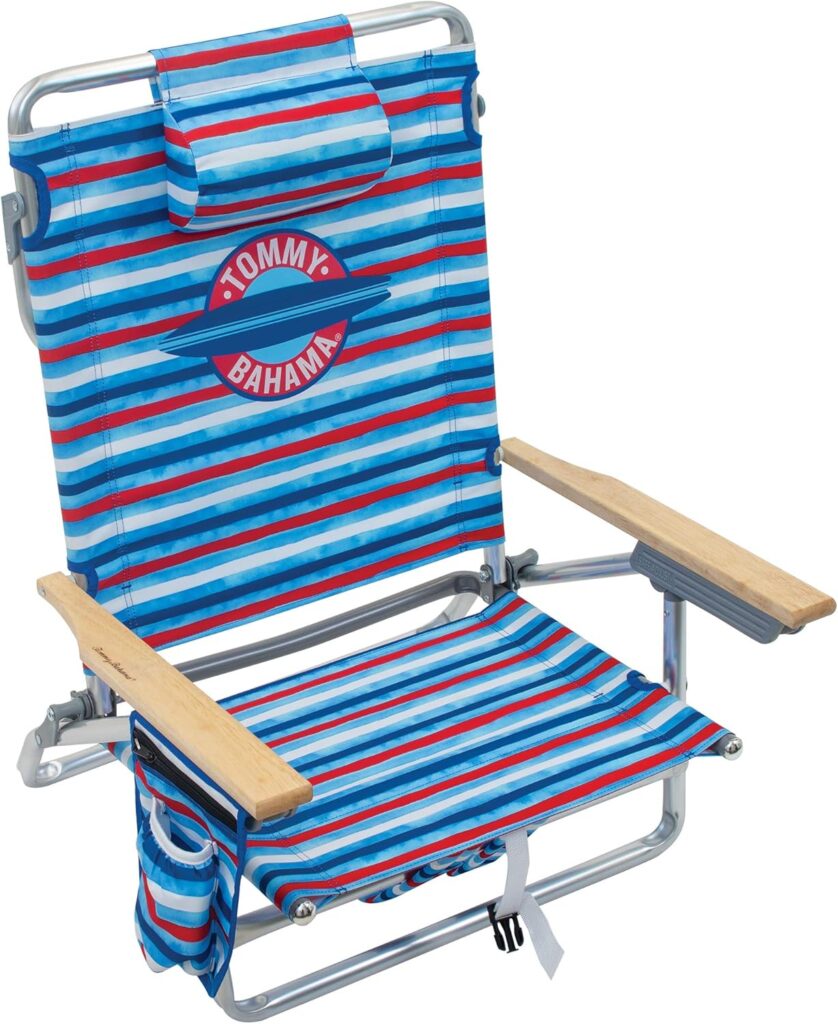How To Clean Beach Chairs Without Losing Your Mind
Let’s face it: how to clean beach chairs isn’t something you Google unless your favorite one smells like last summer’s shrimp boil or looks like it was dragged through a sandstorm by a caffeinated crab. But here we are.
Whether you left it in the trunk since July or it’s sprouting mildew like a garden experiment, I’m here to help – minus the lecture, plus some personal beach chair trauma and expert-backed solutions.
How to Clean Beach Chairs
Looking for how to clean beach chairs? Let’s not dance around the bonfire: how to clean beach chairs comes down to three crucial steps, no matter the material:
- Shake or vacuum out the sand and debris.
- Scrub using a safe cleaner based on the chair’s material (vinegar + dish soap works wonders).
- Let it dry completely in the sun to prevent mildew and stink.
If you’re dealing with stubborn stains, rust, or mold, buckle up – because we’re about to dive deep like you just sat down and realized your chair was wet… again.
Know Your Chair: What’s It Made Of?
Beach chairs are not one-material-fits-all. Before you unleash your inner cleaning warrior, you need to identify what you’re working with:
- Fabric/Mesh: Common in foldable chairs; great for comfort, tricky for cleaning.
- Plastic: Durable and easy, but prone to discoloration.
- Aluminum/Metal: Lightweight and strong, but rust loves these.
- Wood: Classy, but easily damaged by moisture and harsh cleaners.
⚠️ Pro Tip: Never use bleach on fabric or wood beach chairs. It causes fading, breakdown, and eventually, chair retirement (the bad kind).
How to Clean Fabric or Mesh Beach Chairs Like a Pro

This is where the gunk hides. Think sunscreen stains, salty residue, spilled drinks, and the unmistakable scent of “what is that?”
Tools You’ll Need:
- Soft-bristle brush or sponge
- Bucket with warm water
- Dish soap + white vinegar (equal parts)
- Spray bottle (optional)
- Garden hose
Steps:
- Shake it out or vacuum: Get rid of all the sand and crumbs. You’ll be shocked what lives in the creases.
- Spray with your DIY cleaning mix: Let it sit for 10 minutes to penetrate stains.
- Scrub gently: Use circular motions, and give special attention to headrests and seat seams.
- Rinse well with hose water.
- Dry in full sun – Mother Nature’s mildew killer.
💡 Fact: According to Healthline, vinegar is a safe disinfectant that kills 82% of mold species. That’s more than your mom’s lemon-scented all-purpose spray.
READ ALSO: Are Beach Chairs Bad For Your Back
How to Clean Plastic or Aluminum Beach Chairs
These chairs can handle a bit more elbow grease – but not too much.
What You’ll Need:
- Baking soda
- Sponge or soft brush
- Dish soap
- Magic eraser (for extra grime)
- Water hose or spray nozzle
Steps:
- Make a paste of baking soda and water – great for stains and greasy buildup.
- Scrub all surfaces, especially around hinges and frame joints.
- Use a toothbrush to get into tricky corners.
- Rinse with water and let it dry completely.
✨ Fact: Aluminum naturally oxidizes, but that chalky surface can be cleaned with vinegar or a dedicated aluminum cleaner.
How to Clean Mold or Mildew Off Beach Chairs
Beach chairs left damp are a petri dish for mold. You’ll know by the musty smell, black spots, or if your chair smells like a swamp witch’s laundry basket.
What to Use:
- White vinegar (not diluted)
- Hydrogen peroxide (for stubborn areas)
- Baking soda (natural deodorizer)
- Spray bottle
Steps:
- Spray white vinegar directly on affected areas.
- Let sit for 20–30 minutes.
- Sprinkle baking soda over it, then scrub gently.
- Rinse and dry thoroughly.
🧠 Fact: The EPA recommends using vinegar as a first response to non-porous surface mold before resorting to harsh chemicals.
Rust on Frames? Here’s How to Remove It
You’re not alone if your aluminum-framed chair is developing those unsightly orange streaks.
Rust Fix Kit:
- Lemon juice + baking soda
- Steel wool (gentle-grade)
- Anti-rust spray or WD-40 (optional)
Process:
- Apply lemon juice and baking soda paste to rust spots.
- Wait 10 minutes, then gently scrub with steel wool.
- Wipe clean and dry.
- Spray a rust-inhibitor if you plan to store it long-term or near water.
💬 User Tip: One reader said they salvaged their dad’s 20-year-old chair with just lemon juice and elbow grease. That’s one less item in a landfill.
Cleaning Those Pesky Hinges and Hidden Spots
Sand and sunscreen love to hide in folds, hinges, and seams – aka “The Bermuda Triangle of Cleanliness.”
Tools:
- Old toothbrush
- Q-tips
- Compressed air (yes, like for your keyboard)
How:
- Open every fold or hinge.
- Use your brush to loosen up debris.
- Blow out stubborn particles with compressed air.
- Wipe with a soapy rag and rinse.
💡 Why are beach chairs so low? Blame it on portability and comfort – but unfortunately, it also makes cleaning them trickier unless you’re part yogi.
How to Clean Canvas Beach Chairs (Without Summoning a Fabric Exorcist)
Canvas beach chairs are the dependable old friends of the shore – soft, breathable, and suspiciously good at trapping sand since 1998. But they also stain like they’re auditioning for a Tide commercial.
What You’ll Need:
- Warm water
- Mild dish soap
- White vinegar
- Soft scrub brush or sponge
- A spray bottle (optional, but makes you feel like a professional)
Steps:
- Shake out every last grain of sand. Turn it upside down. Smack it like it owes you rent. Trust me, sand hides in emotional support creases.
- Mix 1 part vinegar, 1 part water, and a dash of dish soap.
- Spray or scrub the canvas evenly. Let the solution sit for 10 minutes, or until it has absorbed your regrets and sunscreen stains.
- Scrub with care – canvas isn’t indestructible. Use circular motions like you’re giving it a relaxing spa day, not a deep tissue massage.
- Rinse thoroughly with a garden hose or bucket.
- Air dry in full sun. UV rays naturally disinfect, and let’s be honest, everything looks better after sunbathing.
✨ Canvas secret: A light coat of fabric protector spray after cleaning can repel water and new stains. Think of it as sunscreen for your chair.
How to Clean Tommy Bahama Beach Chairs (Yes, They Deserve Special Treatment)
Tommy Bahama beach chairs are the Ferraris of sand seating – multiple reclining levels, built-in coolers, and enough pockets to lose three snacks and your dignity. Cleaning them? A bit more delicate, a lot more satisfying.
Tools You’ll Need:
- Warm water
- Dish soap
- Soft brush or microfiber cloth
- White vinegar
- Old toothbrush (for the 14 cupholders and secret compartments)
Steps:
- Empty every pocket. Don’t act surprised when you find last year’s granola bar.
- Brush off debris and vacuum if needed (yes, a vacuum).
- Mix warm water, dish soap, and vinegar, then wipe down the fabric and frame.
- Scrub fabric gently using a microfiber cloth. That embroidered logo isn’t going to appreciate aggression.
- Focus on the aluminum frame. A vinegar wipe can cut through salt buildup and surface grime.
- Dry completely. Preferably reclining under the sun like the chair deserves.
🎯 Pro tip: These chairs often have rust-resistant aluminum, but they’re not invincible. After cleaning, towel-dry the metal parts to keep them looking beach-body ready.
How to Clean Beach Chairs With Vinegar (The Natural MVP)

If cleaning with vinegar makes you feel like a wizard using potion magic, you’re not wrong. It’s non-toxic, cheap, and gets the job done better than half your exes.
Why Vinegar?
- Kills bacteria and mildew
- Deodorizes without chemicals
- Safe for kids, pets, and clumsy snackers
What to Do:
- Mix equal parts white vinegar and warm water. Add a few drops of lemon juice if you want it to smell like effort.
- Spray or soak the dirty zones, particularly around the armrests, headrest, and, let’s be real, snack-landing zones.
- Let it sit for 10–15 minutes.
- Scrub gently with a soft brush, focusing on moldy or stained areas.
- Rinse and dry. If the chair sizzles in the sun, you did great.
🍃 Extra bonus: Vinegar is biodegradable, so your clean-up isn’t polluting the very beach you love. Mother Nature gives you a subtle thumbs-up.
How to Clean Beach Chairs Without Bleach (Because It’s Not Always the Answer)

Bleach might seem like the nuclear option for cleaning, but let’s not go there unless your chair is auditioning for a ghost movie.
It’s harsh, smells like regret, and can destroy fabrics over time. Luckily, there are safer, gentler options that work just as well – without bleaching your navy blue chair into a sad, faded blue jean.
Bleach-Free Cleaning Recipe
- 1 cup white vinegar
- 2 tablespoons baking soda
- Warm water
- Lemon juice (optional, but fancy)
What to Do
- Combine all ingredients and stir until bubbly. Feel accomplished.
- Apply the mix using a cloth or sponge.
- Let it sit for 10–20 minutes. Enough time to wonder why you didn’t do this sooner.
- Scrub and rinse.
- Dry it like it just finished hot yoga – out in the sun, with lots of space to breathe.
☀️ Note: Never store a damp chair indoors, unless you’re starting a mildew collection.
How to Clean Beach Chair Stains (Including the Mysterious Ones)
Stains are the beach chair’s personal tattoos – each one with a story (usually involving nachos or coconut oil). Here’s how to make them a thing of the past.
Common Offenders:
- Sunscreen (oily and sneaky)
- Mold (black/green and terrifying)
- Drink spills (hello, sangria ghost!)
- Salt stains (chalky and stubborn)
How to Fight Back:
- Sunscreen stains: Use dish soap and warm water; scrub with a soft brush.
- Mold: Spray with undiluted vinegar, scrub with baking soda.
- Drink stains: Use lemon juice directly and let the sun bleach it out naturally.
- Salt marks: Wipe with vinegar-water mix and rinse.
💡 If a stain is really dug in, try a paste of baking soda and hydrogen peroxide – but test a patch first to avoid accidental bleaching. Chairs don’t like surprises either.
How to Dry Beach Chairs: Don’t Skip This!
Mildew’s BFF is moisture. Even after you clean, drying properly is critical.
- Let your chair sunbathe for 4–6 hours.
- Set it on bricks or hang it to dry to allow airflow underneath.
- NEVER store a damp chair in a trunk, shed, or beach bag.
Natural and Kid-Safe Cleaning Solutions
If your toddler snacks directly off your chair (as mine does), you’ll want to avoid chemicals. Here’s a mix that’s powerful and safe:
- 1 part white vinegar
- 1 part warm water
- 1 tbsp lemon juice
- Optional: 5 drops of lavender oil for scent
Spray and wipe down after each trip – your chair will last longer and smell less like wet gym sock.
Restoration vs. Retirement: Can You Save That Chair?
If your chair is:
- Sagging
- Stained beyond recognition
- Rusted through
It may be time for an upgrade. But don’t toss it just yet! Consider:
- Replacing the fabric sling
- Repainting the frame
- Adding new grips or feet
This is your chance to turn your crusty companion into the best high beach chair in your friend group’s arsenal.
What Not To Do
Please don’t:
- Pressure wash a fabric chair (unless you want a beach chair crime scene)
- Use harsh bleach on aluminum or mesh
- Store it damp “just for now”
Think of your chair like a cat: clean it regularly, store it properly, and don’t scare it with high-pressure water.
Bonus Bites (Because You’re Still Here, You Legend)
- Planning a Valentine’s Day at the beach? Clean your chair beforehand – nothing kills romance like mildew butt prints.
- Love lounging? Treat yourself to the best beach rocking chair – but keep it squeaky-clean!
- If you’re into water sports, rinse your chair weekly. Saltwater buildup causes damage fast.
- The best beach chair and umbrella combo only stays “best” with some TLC and a yearly scrub.
And don’t forget your beach necessities: snacks, sunscreen, and now – a clean, fresh-smelling chair.
The Bottom Line on How to Clean Beach Chairs
So, how to clean beach chairs? It’s not rocket science, but it is an art – equal parts patience, vinegar, and grit. Whether it’s stained from sunscreen, streaked with rust, or just smells like your last crab boil, the fix is here.
Now go forth. Reclaim your sun-faded throne. And next time someone says, “Hey, your beach chair smells nice!” – you’ll know who to thank (spoiler: it’s you).




